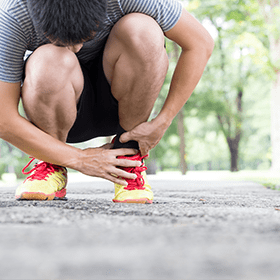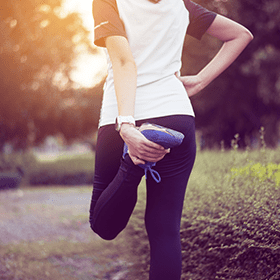By Ben Fletcher
Getting on Top of Hip Pain: An Exercise Plan
The hip joint is a ball and socket joint connecting the lower limb to the pelvic girdle. Because of this, the hip is able to move in multiple directions. It is the muscles that surround the hip that are responsible for creating stability in the hip and producing movement. These muscles include the hip flexors, gluteal muscles, hamstrings, adductors, quadriceps and lower abdominals.
The hip joint is in action a lot throughout our everyday lives in use not just during more intense activities like running and jumping, but during simple tasks like standing or walking too. As a result, the hip joint is usually quite durable. That said, its durability does not make it immune to musculoskeletal injury, or more run of the mill aches and pains. In order to avoid the onset of hip pain or mitigate the risk of picking up an injury, it is important to keep our hips healthy.
When it comes to maintaining a healthy hip, it is important to strengthen and develop all of the muscles in that region of the body. I have created two phases that you can work through below:
Phase 1
Here, you start to gently put load through the muscles surrounding the hip. Performing the exercises below will directly load the tissues in and around the hip, and start to increase hip strength and stability.
Side lying hip adduction
- Start by straightening your leg, then contracting your inner groin area to lift your leg off the floor and then slowly lower it back down.
- Rather than worrying about how high you lift your leg during this, focus more on squeezing your adductors in doing so, you should really feel this exercise working your inner thigh area.
Lying band hip flexion
- Lie on your back ensure your back is flat on the floor by engaging your core and keeping your ribs down.
- With the band around your foot, bend your knee towards your chest, finishing with your hip and knee at 90 degrees.
Clams
- Engage your core to keep your trunk in a fixed position.
- Squeeze your glutes and think about lifting your top knee and rotating it backwards while pushing your bottom knee into the floor.
- You should feel the muscles on the top and back of the hip working.
- Notice that nothing else moves i.e. there is no movement in your spine and your hips stay square.
Hip bridge with adductor squeeze
- For this exercise, you can place pretty much anything between your knees I'm using a light medicine ball in the video above.
- The important thing to note is that you should squeeze the ball the entire time which means you should feel the muscles on the inside part of your thigh working too.
- As you hold the squeeze, perform a bridge which will work the muscles in the back of the hip.
Hamstring bridge
- Start with your hips and knees at 90 degrees, with your core engaged so your back is flat on the floor.
- Think about driving through your heels to raise your hips off the floor until you have a straight line form your knees to your shoulders.
Feet only deadbug
- During this exercise it is really important that your back stays flat on the floor and doesn't arch up.
- Flatten your back against the floor by engaging your abdominal muscles - notice your ribs lowering and your pelvis tucking.
- Also notice that when you relax, your ribs flare and your back arches off the floor.
- You want to straighten one leg while keeping the other leg in a fixed position.
- If you do notice that your back starts to arch up when you straighten your leg, then simply straighten your leg to just before your back arches and no further.
- As your core strength improves you will be able to reach your leg further.
Phase 2
In phase 2 you will notice that the exercise difficulty and the load through the tissues surrounding the hip starts to increase.
Copenhagen isometric hold
- This exercise is similar to the side plank; however, the difference is you place your upper leg on a bench or something similar. This allows you to strengthen your inner thigh.
- I have positioned my knee on a bench in the video above, but if you want to make the exercise more difficult, you can place your foot on the bench.
- It's important to make sure your body is straight from shoulder to your knee, and don't let your hips drop.
Single leg hip bridge with band hip flexion
- To progress this exercise from the last phase, you will now look to perform a single leg hip bridge as you bend your knee towards your chest with the band around your foot.
- This exercise will strengthen the muscles in the back of the hip as you perform the bridge, as well as the muscles on the front of your hip.
Band resisted clams
- The coaching points here are the same as in phase one. The difference from the last phase is that you position a band around your knees.
- By placing a band around your knees, you are adding resistance and therefore, increasing the difficulty.
Single leg hip bridge with adductor squeeze
- Again, the important thing to remember is that you should squeeze the ball the whole time to work the muscles on the inside part of your thigh.
- The progression here is that as you hold the squeeze, you perform a single leg bridge.
Swiss ball hamstring curls
- Start with your legs straight, then think about driving your heels into the ball causing your knees to bend.
- Notice how my hips also raise to create a straight line from my shoulder to my knee.
- You should keep your hips up throughout the entire exercise.
Deadbug
- You will now introduce your arms into this exercise by raising the opposite arm above your head as you straighten your leg.
- Again, it is really important that your back stays flat on the floor and doesn't arch up.
- If you are unable to keep your back flat, try going back to the legs only variation.
Strength Development
It is important to strengthen the muscles surrounding the hip; however, it is also important to get stronger, not just in the muscles around your hip, but in your whole body.
You can find details of our total body strength workout here. This workout includes multiple lower and upper body movements allowing you to strengthen all of the major joints and muscles of the body. Although there are many to choose from, this programme includes some of my go-to exercises when it comes to strength development. It also gives you some guidance on how to progress your workouts as your strength improves.
Important to note
The above information is not intended to be medical advice tailored specifically for you. The first steps towards dealing with hip pain should be to consult with a medical professional and have your injury assessed so you have a proper diagnosis. The professional in question can then help you with the rehabilitation by creating a personalised programme.

